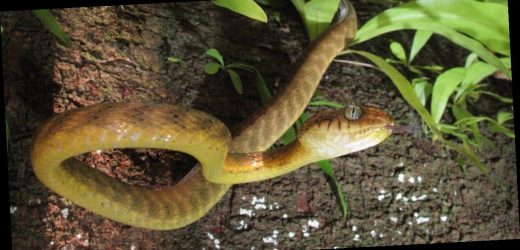- A new study shows a species of tree snake uses an unprecedented form of locomotion in order to climb objects like trees.
- The brown tree snake loops its body into a lasso around wide, cylindrical objects in order to ascend them.
- This lasso technique likely helps the snake scale wider trees and hunt birds nesting in the canopy.
- Visit Business Insider's homepage for more stories.
The brown tree snake loves to snack on birds.
One of the world's most prolific invasive species, this tropical predator decimated bird populations on Guam over the last 70 years.
Now scientists may have figured out how.
According to a new study published in the journal Current Biology, brown tree snakes can climb an object like a tree trunk by wrapping their bodies around it in a lasso shape and shimmying upward.
Scientists have never before seen this type of locomotion in the reptile world.
"I've been working on snake locomotion for 40 years and here, we've found a completely new way of moving," Bruce Jayne, a study co-author and biologist from the University of Cincinnati, said in a press release.
It's likely this lasso locomotion enables the predators to climb wider, smoother objects, and exploit "resources that might otherwise be unobtainable," the study authors wrote — resources like birds.
'Nothing I'd ever seen compares to it'
Scientists discovered the snakes' climbing skills by accident.
In 2016, two biologists from Colorado State University (CSU) were puzzling out how to protect Micronesia starlings, one of Guam's two remaining native bird species, from predators.
They hoped to place the starlings' nesting boxes on the top of 3-foot-long poles surrounded by a wide, metal collar called a baffle. Typically, these steel baffles prove too slick for raccoons or snakes looking for an easy meal.
To test their idea, they placed mice in a cage atop the baffle, and left the 6-inch-wife baffles under infrared video surveillance in an enclosure with 58 brown tree snakes.
Under cover of darkness, nine of those snakes outsmarted the scientists.
"We had watched about four hours of video and then all of a sudden, we saw this snake form what looked like a lasso around the cylinder and wiggle its body up," Tom Seibert, a coauthor of the study and one of the two CSU biologists, said in a press release. "It was a shocker. Nothing I'd ever seen compares to it."
Most snakes climb trees by wrapping their bodies twice around the trunk, then alternating between squeezing muscles in their top loop to pull up their bottom half then squeezing with their bottom loop to extend their heads upward.
That type of movement, know as concertina locomotion, is a bit like someone switching between their arms and feet to scale a rope.
Concertina locomotion is an efficient way for snakes to move. But it only works if the tree is skinny enough that a snake can wrap its body around the trunk twice — baffles are designed to be too wide for snakes to use concertina locomotion.
Lasso locomotion, by contrast, only requires the snake to wrap its coils around an object once.
That means brown tree snakes can scale cylinders (like baffles, or trees) twice as wide as their concertina-using counterparts, according to Jayne.
A slow, steady shimmy
Seibert and his team returned to Guam in 2019 to get additional footage. This time, they tested the climbing skills of 15 brown tree snakes. One-third of them scaled the metal baffles using the same lasso movement.
While lasso locomotion may help these snakes scale wider trees and plunder the starlings nesting in the canopy, it's not easy, Jayne said. The footage showed the snakes were breathing heavily, and frequently had to stop climbing.
"Even though they can climb using this mode, it is pushing them to the limits. The snakes pause for prolonged periods to rest," he said.
All told, the snakes shimmied up the baffles at a speed of less than half a centimeter (0.2 inches) per second, slipping and sliding as they went.
Source: Read Full Article


